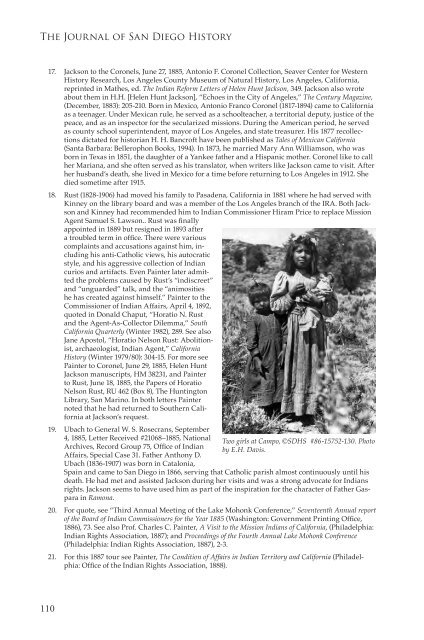The Journal of San Diego History - San Diego History Center
The Journal of San Diego History - San Diego History Center
The Journal of San Diego History - San Diego History Center
Create successful ePaper yourself
Turn your PDF publications into a flip-book with our unique Google optimized e-Paper software.
<strong>The</strong> <strong>Journal</strong> <strong>of</strong> <strong>San</strong> <strong>Diego</strong> <strong>History</strong><br />
17. Jackson to the Coronels, June 27, 1885, Antonio F. Coronel Collection, Seaver <strong>Center</strong> for Western<br />
<strong>History</strong> Research, Los Angeles County Museum <strong>of</strong> Natural <strong>History</strong>, Los Angeles, California,<br />
reprinted in Mathes, ed. <strong>The</strong> Indian Reform Letters <strong>of</strong> Helen Hunt Jackson, 349. Jackson also wrote<br />
about them in H.H. [Helen Hunt Jackson], “Echoes in the City <strong>of</strong> Angeles,” <strong>The</strong> Century Magazine,<br />
(December, 1883): 205-210. Born in Mexico, Antonio Franco Coronel (1817-1894) came to California<br />
as a teenager. Under Mexican rule, he served as a schoolteacher, a territorial deputy, justice <strong>of</strong> the<br />
peace, and as an inspector for the secularized missions. During the American period, he served<br />
as county school superintendent, mayor <strong>of</strong> Los Angeles, and state treasurer. His 1877 recollections<br />
dictated for historian H. H. Bancr<strong>of</strong>t have been published as Tales <strong>of</strong> Mexican California<br />
(<strong>San</strong>ta Barbara: Bellerophon Books, 1994). In 1873, he married Mary Ann Williamson, who was<br />
born in Texas in 1851, the daughter <strong>of</strong> a Yankee father and a Hispanic mother. Coronel like to call<br />
her Mariana, and she <strong>of</strong>ten served as his translator, when writers like Jackson came to visit. After<br />
her husband’s death, she lived in Mexico for a time before returning to Los Angeles in 1912. She<br />
died sometime after 1915.<br />
18. Rust (1828-1906) had moved his family to Pasadena, California in 1881 where he had served with<br />
Kinney on the library board and was a member <strong>of</strong> the Los Angeles branch <strong>of</strong> the IRA. Both Jackson<br />
and Kinney had recommended him to Indian Commissioner Hiram Price to replace Mission<br />
Agent Samuel S. Lawson.. Rust was finally<br />
appointed in 1889 but resigned in 1893 after<br />
a troubled term in <strong>of</strong>fice. <strong>The</strong>re were various<br />
complaints and accusations against him, including<br />
his anti-Catholic views, his autocratic<br />
style, and his aggressive collection <strong>of</strong> Indian<br />
curios and artifacts. Even Painter later admitted<br />
the problems caused by Rust’s “indiscreet”<br />
and “unguarded” talk, and the “animosities<br />
he has created against himself.” Painter to the<br />
Commissioner <strong>of</strong> Indian Affairs, April 4, 1892,<br />
quoted in Donald Chaput, “Horatio N. Rust<br />
and the Agent-As-Collector Dilemma,” South<br />
California Quarterly (Winter 1982), 289. See also<br />
Jane Apostol, “Horatio Nelson Rust: Abolitionist,<br />
archaeologist, Indian Agent,” California<br />
<strong>History</strong> (Winter 1979/80): 304-15. For more see<br />
Painter to Coronel, June 29, 1885, Helen Hunt<br />
Jackson manuscripts, HM 38231, and Painter<br />
to Rust, June 18, 1885, the Papers <strong>of</strong> Horatio<br />
Nelson Rust, RU 462 (Box 8), <strong>The</strong> Huntington<br />
Library, <strong>San</strong> Marino. In both letters Painter<br />
noted that he had returned to Southern California<br />
at Jackson’s request.<br />
19. Ubach to General W. S. Rosecrans, September<br />
4, 1885, Letter Received #21068–1885, National<br />
Archives, Record Group 75, Office <strong>of</strong> Indian<br />
Affairs, Special Case 31. Father Anthony D.<br />
Ubach (1836-1907) was born in Catalonia,<br />
Two girls at Campo, ©SDHS #86-15752-130. Photo<br />
by E.H. Davis.<br />
Spain and came to <strong>San</strong> <strong>Diego</strong> in 1866, serving that Catholic parish almost continuously until his<br />
death. He had met and assisted Jackson during her visits and was a strong advocate for Indians<br />
rights. Jackson seems to have used him as part <strong>of</strong> the inspiration for the character <strong>of</strong> Father Gaspara<br />
in Ramona.<br />
20. For quote, see “Third Annual Meeting <strong>of</strong> the Lake Mohonk Conference,” Seventeenth Annual report<br />
<strong>of</strong> the Board <strong>of</strong> Indian Commissioners for the Year 1885 (Washington: Government Printing Office,<br />
1886), 73. See also Pr<strong>of</strong>. Charles C. Painter, A Visit to the Mission Indians <strong>of</strong> California, (Philadelphia:<br />
Indian Rights Association, 1887); and Proceedings <strong>of</strong> the Fourth Annual Lake Mohonk Conference<br />
(Philadelphia: Indian Rights Association, 1887), 2-3.<br />
21. For this 1887 tour see Painter, <strong>The</strong> Condition <strong>of</strong> Affairs in Indian Territory and California (Philadelphia:<br />
Office <strong>of</strong> the Indian Rights Association, 1888).<br />
110






![[PDF] The Journal of San Diego History Vol 52: Nos 1 & 2](https://img.yumpu.com/25984149/1/172x260/pdf-the-journal-of-san-diego-history-vol-52-nos-1-2.jpg?quality=85)

![[PDF] The Journal of San Diego History - San Diego History Center](https://img.yumpu.com/25984131/1/172x260/pdf-the-journal-of-san-diego-history-san-diego-history-center.jpg?quality=85)







